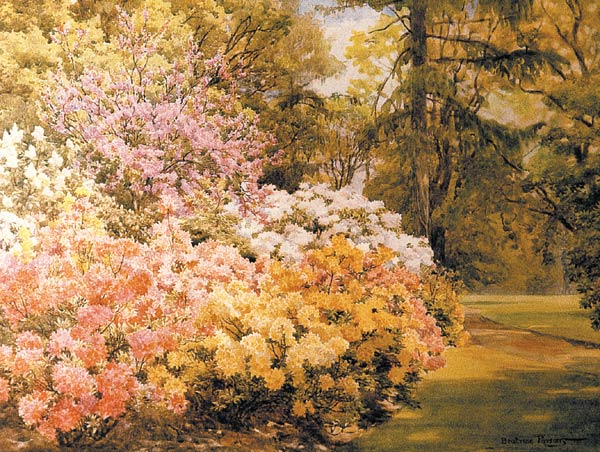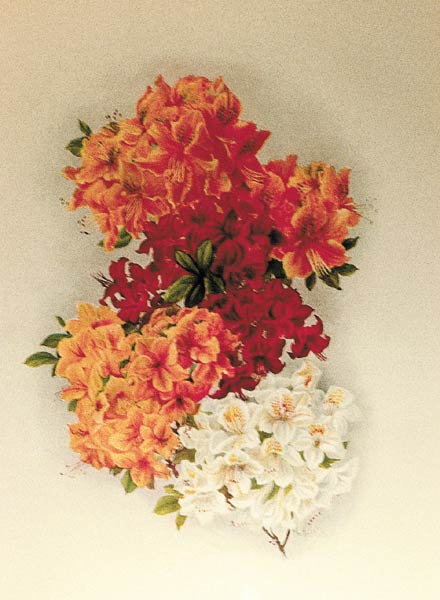JARS v57n2 - Notes on Selected Illustrations from J. G. Millais' Two Volumes Rhododendrons and The Various Hybrids, Part III
Notes on Selected Illustrations from J. G. Millais' Two
Volumes Rhododendrons and The Various Hybrids, Part III
Clive L. Justice
Vancouver, British Columbia
Canada

|
|---|
Azaleas. A Colour Group at South Lodge Horsham (May) by Beatrice Parsons |
Azaleas: A Colour Group at South Lodge Horsham by Beatrice Parsons.
South Lodge was the Surrey garden of Mr. Fred Godman, in whose greenhouse the Rhododendron griffithianum with the large flowers was grown that was used to create the R. Loderi grex. The azaleas pictured in the South Lodge border were called R. molle , and as Millais writes under the R. MOLLE heading in his 1917 volume:
"Valuable as R. molle is for forcing 1 [for house plants], it is still more delightful as a garden shrub when planted in masses with due attention to colour...The colour of R. molle now varies from pure white through all shades of yellow to orange, red and purplish red, so that to get rich effects they should be grouped with some skill...If the gardener wishes for a good clean yellow, he must plant 'Mrs. L. J. Endtz'...
Those who admire autumn colour will find an additional charm in R. molle just before it drops its leaves. These turn crimson, purple brown, and yellow and are sometimes most attractive before they fall. Those who wish to see R. molle in perfection should witness the wonderful display made by hundreds of plants at Leonardslee and South Lodge in the second and third week of May. Miss Parson's beautiful pictures give some idea of the feast of colour that may be seen in these two gardens."
Millais goes on to list the 20 named varieties of R. molle from 'Alphonse Lavallée - bright orange - to 'J. C. Van Tol' - red-late. He lists the 35 named varieties of R. molle X R. sinense from 'Louis Endtz' - orange-yellow - to 'Duchess of Portland' - cream marked with brown and tinged with pink. Millais adds a note at the end of the latter list:
"Vuylsteke [Ghent, Belgium breeder of azaleas in the 1890s] has also made many beautiful crosses between R. molle and Azalea Altaclerense [ molle x viscosum ], whilst the number of unknown seedlings raised by Koster and Anthony Waterer between R. molle and Ghent Azaleas are too numerous to mention...The sweet scented white Azalea known as A. Daviesi is supposed to be the result of a crossing R. molle with R. viscosum , but is more likely to be a hybrid with R. occidentale ." 2
After several more lists, there is the Double Rustica Flora Pleno group with 24 names from 'Aida', a nearly pure white, 'Byron', 'Milton' and 'Rubens', pure white, white and yellowish white respectively, to 'Fenelon', a salmon with pale pink edges. He finishes with a list of names [6] that are hybrids of R. molle and the evergreen rhododendron hybrids 'Prince Camille de Rohan' 3 ( R. caucasicum X R. arboreum ) and R. 'Leopard(i)' ( R. arboreum ssp. x R. caucasicum ?). At the end he writes: "Mr. White of Sunningdale has also raised some hybrids of similar origin, the colour being white and rose and generally well spotted. They retain their leaves in winter and I find them quite hardy and very floriferous."

|
|---|
Hybrid Azaleas by Beatrice Parsons. |
Hybrid Azaleas. Page 73 in Millais Second Series, 1924, titled HYBRID AZALEAS (Anthony Waterer).
The top azalea in the cluster of four is probably the named hybrid 'George Cuthbert' which Millais lists as "apricot, spotted," while the other three, red, orange and white-spotted, are among: "the number of unnamed seedlings raised by...Anthony Waterer between R. molle and Ghent Azaleas [that] are too numerous to mention." 4
ENDNOTES
1
See "Forcing Azalea Mollis" as recounted in Millais, 1917.
2
The latter
occidentale
connection, probably not so. The
R. molle
,
viscosum
circle is squared in Fred Galle's Azaleas, pages 79-89.
3
George Fraser of Eucluelet used this hybrid to create a rhododendron. There is a
lone specimen of this rhodo in the lower parterre of The Womens' University Club garden on
McRae Avenue in Vancouver.
4
Again Fred Galle comes to the rescue, with named varieties of the Anthony Waterer
Ghents and Molles; Anthony is the last of the nurseryman Waterers.
Forcing Azaleas Mollis Text from Millais (1917), page 211; Comments by Clive Justice
Enormous numbers of this popular shrub [
Rhododendron molle
] are grown in Holland, Germany,
and England and used for forcing in early spring. A writer "in the field" Dec. 23, 1911, thus
describes their treatment before flowering.
"The plants of Azalea mollis that are imported for forcing
in this country are from three to six years old, the latter being
about 18 in. High, with from twenty to thirty main shoots, and
about twice as many branchlets, most of them terminated by a
fat flower bud. They are sent over out of pots, the root systems
being so close and mat-like that the plants are not easily upset.
Where only a few are forced it is usual to put them into pots as
soon as they arrive from the dealer, but the market growers have
a different method. They stand the plants together in frames until
they are wanted for forcing, which begins in January and ends
in April. They are taken into the greenhouse, which is kept very
moist and warm, the temperature rarely falling below 70 °[F].
The plants are stood on benches as close together as possible,
and they are frequently syringed overhead. The roof glass is
covered with several layers of mats or even boards, heavy shade
being necessary to force the flower beds (sic, buds are meant)
to push quickly and the stalks to elongate sufficient to make
the developed flower head loose and elegant. The shading is
not removed until the flower buds are nearly full sized, when
more light is admitted, and finally the plants are exposed to all
the light they can get. The next operation is that of gumming, as
soon as possible after it has expanded being visited by a careful
workman, a bicycle oil can in hand, with which he places a
drop of well watered gum at the bottom of the corolla outside,
so that it runs in between the base and the calyx lobes. Each
plant must be gone over three or four times until all the flowers
have been gummed. The hardening off process is then applied,
and the plants are ready to be placed in pots, the rootstock being
often considerably reduced to make it of convenient size, the
plant not objecting in the least. Plants thus treated have been
known to hold their flowers fresh in a dwelling room for nearly
a month. The gum is the most important factor in this. It will be
seen that plants subjected to this course of treatment cannot
be sold for less than 5 shillings each."
Evidently South Lodge had a great range of greenhouses where this
forcing was carried out on a grand scale. It is safe to assume
that this highly labour intensive azalea forcing process went out
as soon as World War I began in 1914 and was never reintroduced.
Think of hand gumming 6 to 10 flowers on 40 to 60 shoots per plant
on 500 plants; that's 120,000 to 300,000 squirts of gum from the
bike oil can with "the plant not objecting in the least." It's
no wonder such abuse of a hand processed potted plant cost US
$1.25 prior to WWI! Today's florist Kurumes, the evergreen
azaleas that are now sold year round, don't have to suffer
this gumming process in order to produce the much too large
and garish flowers that seem now to characterize this popular
houseplant.

